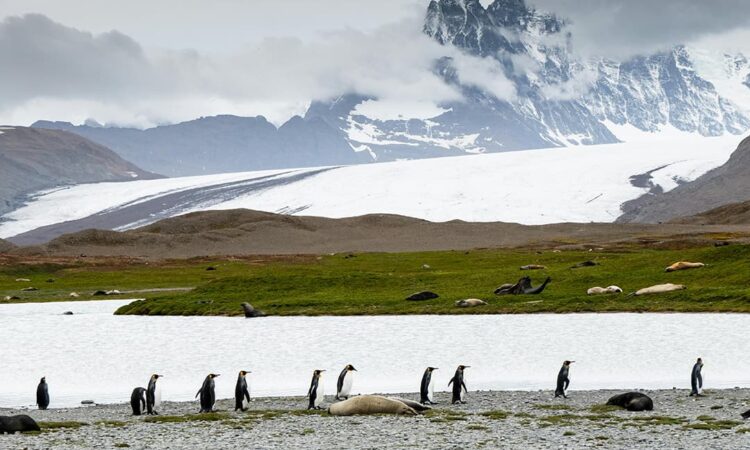The vast, ice-covered Antarctic continent is a major component of the Earth’s global climate system. The high contrast of reflective properties between the white, ice-covered areas and the surrounding dark sea surface in the region plays an important role in regulating regional and global climate. The extremely cold and salty waters around Antarctica sink deep into the ocean, driving a conveyor belt of ocean heat around the world. The Southern Ocean is very efficient at absorbing the greenhouse gas carbon dioxide from the atmosphere as a result of ocean mixing caused by strong westerly winds around the continent.
Analysis of Antarctic ice cores and marine sediments shows that the Antarctic ice sheet has grown and shrunk throughout geological history. Over the past 800,000 years, the Earth has experienced eight ice cycles (each with an ice age and a warm period). Understanding this natural rhythm helps scientists get a better picture of what is happening to the Earth’s climate today and what might happen in the future.
Is Antarctica warming?
Antarctica covers an area larger than Europe, and so there are naturally marked spatial variations in temperature trends. Many long-term measurements at Antarctic research stations show no significant warming or cooling trends, and temperatures across much of the continent have been relatively stable over the past few decades. However, the Antarctic Peninsula and large parts of West Antarctica warmed significantly during the second half of the 20th century, although the warming stabilized in the early 21st century, reflecting the large climate variability in the region.
Despite warmer sea surface and air temperatures over the Southern Ocean, there was a slight overall increase in Antarctic sea ice extent from 1979 to 2014. After that, the sea ice area declined sharply and has since shown significant year-to-year fluctuations, but with a roughly smaller average area. It is believed that these fluctuations are related to changes in atmospheric weather patterns. In contrast, the collapse of the ice shelf (floating glacier extensions) and the decrease in land ice near coastal West Antarctica were caused by warm ocean currents flowing under the ice shelf.
What are the drivers of Antarctic climate change?
We now know that the Antarctic ozone hole has had a profound impact on the Antarctic climate that goes far beyond increasing levels of ultraviolet radiation. As stratospheric ozone concentrations have fallen, temperatures over the continent have also fallen. This creates a greater temperature difference between the tropics and the Antarctic, which affects weather patterns in the Southern Hemisphere. For example, since 1980, winds over the Southern Ocean have increased by about 15%. This has reduced the heating effect of greenhouse gases, affecting the heat balance of the Antarctic atmosphere; heating by flowing inward from lower latitudes and cooling by radiating heat into space. These atmospheric changes have affected the Southern Ocean, which has experienced warming and freshening since the mid-20th century, partly caused by the ozone hole, and a significant role in increasing greenhouse gas concentrations.
The Antarctic climate is also influenced by tropical ocean and atmospheric conditions. Tropical storms and monsoons create waves high in the atmosphere that move to higher latitudes and disrupt polar weather. Evidence now suggests that these processes are linked to the warming of West Antarctica observed in the late 20th century.
What caused the collapse of the shelf glacier around the Antarctic Peninsula?
The Antarctic Peninsula, a long mountainous landmass protruding above the main continent, has experienced dramatic climate change. The eastern part of the Antarctic Peninsula is very sensitive to climate change. Stronger westerly winds in the north of the Antarctic Peninsula, caused mainly by a decrease in stratospheric ozone, have caused marked regional summer warming, which led to the widely publicized retreat and collapse of the northern Larsen Ice Shelf. In October 2006, BAS scientists published the first direct evidence linking human activity to the collapse of the northern Antarctic Peninsula ice shelf in the Journal of Climate.
Climate data from the Antarctic Peninsula show that temperatures in this region rose by about 3.2°C in the second half of the 20th century – more than 3 times the global average – an increase only seen in the Arctic. BAS research has also shown that sea temperatures west of the Antarctic Peninsula have risen by more than 1°C over the same period. It is now generally accepted that the waters of the Antarctic Circumpolar Current are warming faster than the world’s oceans as a whole.
What is the contribution of human activity?
The ozone hole and global warming have changed weather patterns in the Antarctic so that stronger westerly winds force warm air to move eastward over the Antarctic Peninsula’s 2 km high mountain chain. When this happens in summer, temperatures in the northeast of the peninsula rise by about 5°C. In the summer of 2002, this created conditions that favored the drainage of meltwater into crevasses on the Larsen Ice Shelf, a key process that led to its collapse.
What’s next?
Over the next century, despite the expected recovery of ozone in the stratosphere over Antarctica, the effects of increased greenhouse gas emissions are likely to dominate even more and contribute to further strengthening and shifting of the western poles and warming of Antarctica.
It is important that society and political leaders have access to the best scientific evidence and understanding of the likely extent and impacts of global climate change. Reliable observations of past and present climate are needed to attribute observed changes to natural environmental events or to human activity. Many international efforts are aimed at using and improving sophisticated climate models to create better predictions of future changes.
